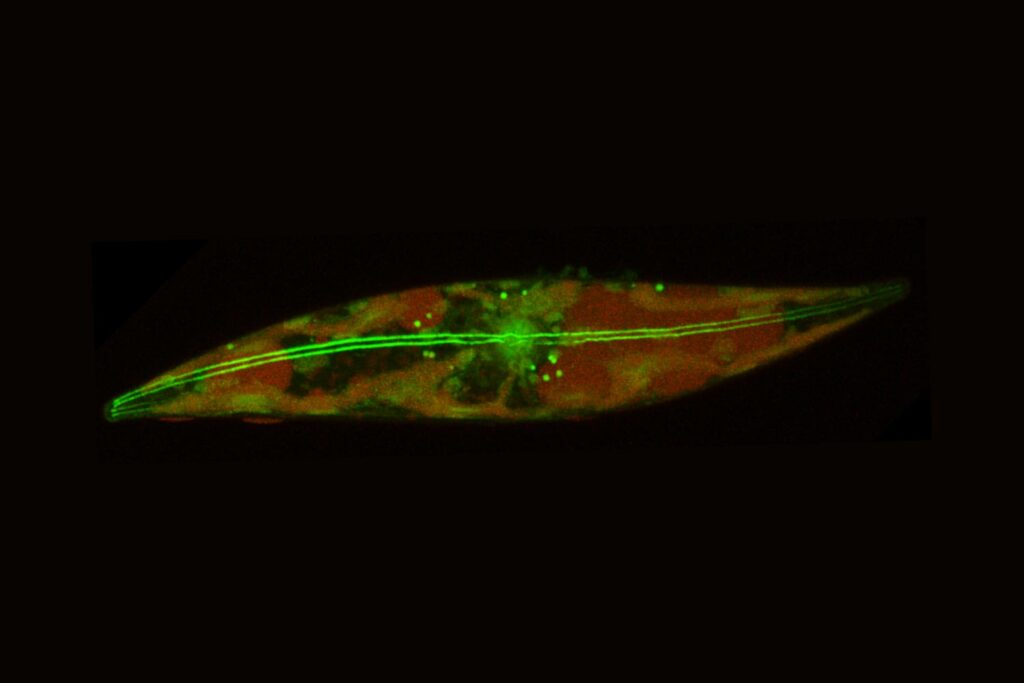
Beneath the Arctic’s frozen surface, tiny algae known as diatoms are challenging the established rules of biology. Their unique survival strategy not only redefines the limits of life but also raises urgent questions about the future of ecosystems threatened by the rapidly melting Arctic ice.
Dormant No More: Arctic Diatoms Come Alive
Drilling into the edges of the Arctic polar cap and extracting an ice core may reveal what appears to be a thin streak of dirt. In reality, these faint lines are composed of diatoms, single-celled algae encased in glass-like shells. While scientists have long been aware of their presence, these organisms were largely overlooked due to their seemingly inactive state.
This assumption has been overturned by a recent study from Stanford University, published on September 9 in the Proceedings of the National Academy of Sciences. The research reveals that Arctic diatoms are far from motionless. Instead of merely enduring the cold, they are actively moving through it, earning a significant place in the scientific record.
Record-Breaking Survival in Extreme Cold
“This is not 1980s-movie cryobiology. The diatoms are as active as we can imagine until temperatures drop all the way down to -15 °C, which is super surprising,” said Manu Prakash, associate professor of bioengineering at Stanford and senior author of the paper. This temperature, equivalent to 5 °F, marks the lowest ever documented for movement in a eukaryotic cell, a type of complex cell found in plants, animals, fungi, and other organisms.
“You can see the diatoms actually gliding, like they are skating on the ice,” noted lead author Qing Zhang, a Stanford postdoctoral scholar who collected samples during an Arctic research expedition. The study demonstrated not only motility at such low temperatures but also that their gliding relies on a combination of mucus and molecular motors.
Inside the Arctic Expedition
The diatoms featured in this research were collected during a 45-day Arctic expedition in the Chukchi Sea aboard the research vessel Sikuliaq, owned by the National Science Foundation and operated by the University of Alaska Fairbanks. Researchers from the Prakash Lab and the lab of Kevin Arrigo, professor of Earth system science at Stanford, gathered ice cores from 12 stations throughout the summer of 2023. Utilizing a range of on-ship microscopes developed over years, the team imaged inside the ice to document the secret lives of these remarkable arctic diatoms.
Back in the lab, the team extracted diatoms from the ice cores and recreated their environments in a petri dish containing a thin layer of frozen freshwater and a layer of very cold saltwater. When ice forms in the Arctic, it expels salt, leaving freshwater ice with small microfluidic channels. The lab replicated these channels using their own hair, allowing the diatoms to slip through these strand-sized highways even as temperatures dropped below freezing.
The Secret of Mucus-Powered Motion
What’s particularly surprising is that the diatoms move without wiggling, scrunching, or using any appendages. Instead, they glide, a common behavior among diatoms. “There’s a polymer, kind of like snail mucus, that they secrete which adheres to the surface, like a rope with an anchor,” explained Zhang. “They pull on that ‘rope’ to move forward.”
This mucilage rope mechanism depends on actin and myosin, the same biological system that drives human muscle movements. How this machinery functions in subzero conditions is now a key research question for the lab. When comparing Arctic diatoms with temperate relatives gliding along glass, the polar species moved much faster, suggesting an evolutionary advantage.
Beneath the Ice: A Hidden Green World
The Prakash Lab maximized their time in the Arctic, gathering extensive data on multiple projects beyond diatoms. This includes drone footage taken under the ice, vividly displaying the potential of this work. “The Arctic is white on top but underneath, it’s green – absolute pitch green because of the presence of algae,” said Prakash. “This is not just a tiny little thing; it’s a significant portion of the food chain and controls what’s happening under ice.”
Urgency in a Disappearing Arctic
Knowing that diatoms are active raises broader questions about adaptation to a changing polar environment. Could they be moving resources through the Arctic food web, nourishing everything from fish to polar bears? Could their mucus trails even seed new ice formation, akin to pearls forming around grains of sand?
Prakash emphasized the urgency of these questions, noting that severe projected budget cuts to the National Science Foundation could reduce polar research funding by 70 percent. “Many of my colleagues are telling me, in the next 25 to 30 years, there will be no Arctic. When ecosystems are lost, we lose knowledge about entire branches in our tree of life,” he said. “The infrastructure and capacity to operate is critical for discovery.”
Reference: “Ice gliding diatoms establish record-low temperature limits for motility in a eukaryotic cell” by Qing Zhang, Hope T. Leng, Hongquan Li, Kevin R. Arrigo, and Manu Prakash, 9 September 2025, Proceedings of the National Academy of Sciences. DOI: 10.1073/pnas.2423725122
Prakash is also a senior fellow at the Stanford Woods Institute for the Environment and an associate professor, by courtesy, of biology and of oceans. Other authors include graduate student Hope T. Leng, Hongquan Li, PhD ’23, and Kevin Arrigo, the Donald and Donald M. Steel Professor of Earth Sciences. This research was funded by the National Science Foundation, a Stanford VPGE DARE fellowship, the Human Frontier Science Program, the Moore Foundation, the Schmidt Foundation, and the Dalio Foundation. Part of this work was performed at the Cell Sciences Imaging Facility at Stanford University.






